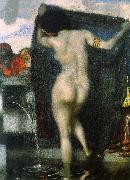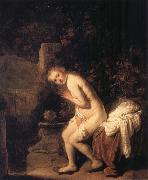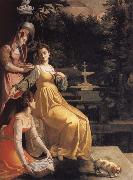
|
Franz von Stuck
|
|||
|
|
|||
| German Symbolist/Expressionist Painter and Sculptor, 1863-1928 Stuck was born at Tettenweis, in Bavaria. From an early age he displayed an affinity for drawing and caricature. To begin his artistic education in 1878 he went to Munich, where he would settle for life. From 1881 to 1885 Stuck attended the Munich Academy. He first made a name with cartoons for Fliegende Blätter, and vignette designs for programmes and book decoration. In 1889 he exhibited his first paintings at the Munich Glass Palace, winning a gold medal for The Guardian of Paradise. In 1892 Stuck co-founded the Munich Secession, and also executed his first sculpture, Athlete. The following year he won further acclaim with the critical and public success of what is now his most famous work, The Sin. Also in 1893, Stuck was awarded a gold medal for painting at the Chicago World's Fair and was appointed to a royal professorship. In 1895 he began teaching painting at the Munich Academy. In 1897 Stuck married an American widow, Mary Lindpainter, and began work designing his own residence and studio, the Villa Stuck. His designs for the villa included everything from layout to interior decorations; for his furniture Stuck received another gold medal at the 1900 Paris World Exposition. Having attained a high degree of fame by this time, Stuck was elevated to the aristocracy on December 9, 1905 and would receive further public honours from around Europe during the remainder of his life. Even as new trends in art left Stuck behind, he continued to be highly respected among young artists in his capacity as professor at the Munich Academy. Notable students of his over the years include Paul Klee, Hans Purrmann, Wassily Kandinsky, and Josef Albers. Franz von Stuck died in 1928; his funeral address memorialized him as "the last prince of art of Munich's great days". He is buried in the Munich Waldfriedhof next to his wife Mary. | |||
|
|
|||
|
Susanna Bathing Franz von Stuck1.jpg Painting ID:: 3712 |
1904 Kunstmuseum St Gallen | ||
|
|
|||
|
REMBRANDT Harmenszoon van Rijn
|
|||
|
|
|||
| Born 1606, Died 1669.One of the great Dutch painters and printmakers of the 17th century, Rembrandt van Rijn is best known for his expressive use of light and shadow (also called chiaroscuro) in his many portraits. Raised in Leiden, he studied with Pieter Lastman (1583-1633) in Amsterdam, then returned to Leiden around 1625 and set up shop as a teacher and portrait artist. Sometime between 1630 and 1632 Rembrandt relocated to Amsterdam, where he spent the rest of his career. Though he had his detractors (some of whom considered him coarse and "low born"), Rembrandt was successful and famous during his lifetime, though he fell on financial hard times in his later years. He was a master printer and produced hundreds of group portraits and historical paintings, including The Anatomy Lesson of Dr. Tulp (1632), The Military Company of Captain Frans Banning Cocq (1642) and Aristotle with a Bust of Homer (1653). His portraits -- including a lifelong trail of intriguing and rather frank self-portraits -- reveal his interest in psychological study and continue to be admired as landmarks in Western art. The Military Company of Captain Frans Banning Cocq is also known as "The Night Watch" because it was thought the painting depicted a nighttime scene. When the painting was cleaned in the 1940s it became obvious that it depicted a daytime scene... He married Saskia van Ulenburgh (also Uylenburgh) in 1634. | |||
|
|
|||
|
Susanna Bathing new10/REMBRANDT Harmenszoon van Rijn-974323.jpg Painting ID:: 34461 |
mk93 1634 Oil on panel 18 1/2x15 1/4in Mauritshuis.The Hague | ||
|
|
|||
|
Jacopo da Empoli
|
|||
|
|
|||
| 1554-1640 Italian Jacopo da Empoli Location Italian painter and draughtsman. He lived and worked in Florence all his life, and he followed Santi di Tito in the return to the clarity of the Florentine High Renaissance. He absorbed the ideas of his more innovative contemporaries and became one of the most popular painters of altarpieces for churches in Florence and Tuscany. He was also a distinguished still-life painter and received many commissions from private patrons, among them the Medici. Empoli painting is distinguished by simple, lucid forms, strong colour and direct and clear interpretation of the subject. | |||
|
|
|||
|
Susanna bathing new12/Jacopo da Empoli-359922.jpg Painting ID:: 39628 |
mk150 1600 229x172cm | ||
|
|
|||
|
Also Buy::. For Following Paintings / Artists / Products, Please Use Our Search Online: |










